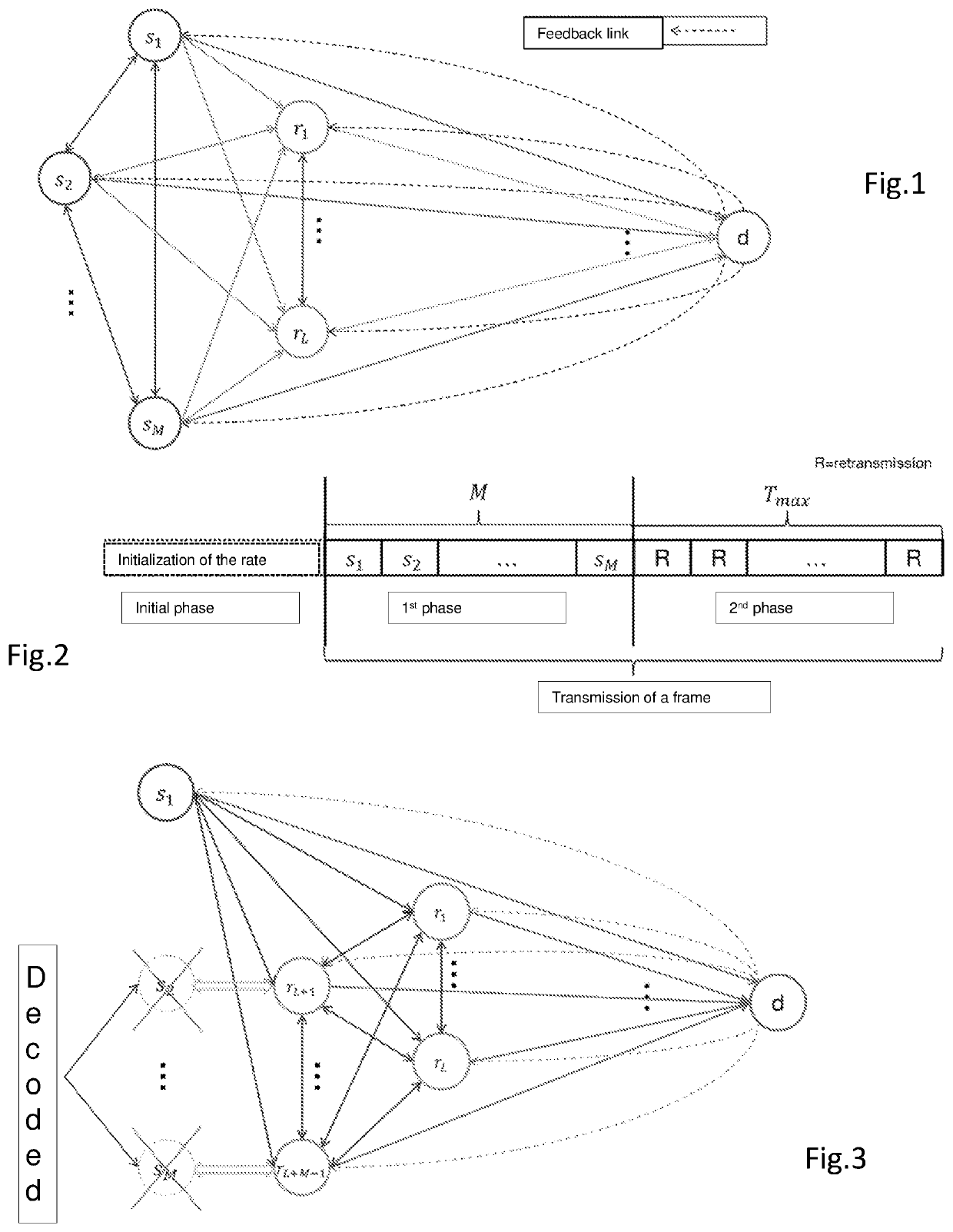OMAMRC transmission method and system with slow link adaptation
a transmission method and link adaptation technology, applied in the field of digital communication, can solve the problems and the subject of slow fading and gaussian white noise of links between the different nodes of the system
- Summary
- Abstract
- Description
- Claims
- Application Information
AI Technical Summary
Benefits of technology
Problems solved by technology
Method used
Image
Examples
first embodiment
[0179]A first embodiment considers a common ACK / NACK message and a selection of a relay node based on the mutual item of information.
[0180]According to this embodiment, only one subset is considered in the equation (6). This subset is that which comprises all the sources of the set of the sources not correctly decoded by the destination, i.e. ′=d,t−1. Thus, at the start of the round t, the destination chooses the cooperative node at E at∈∪ which maximizes.
[0181]a^t={∑s∈𝒮_d,t-1Is,d+∑l=1t-1αIa^l,d1{𝒮_d,t-1⋂𝒮^al,l-1≠ϕ}+αIat,d1{𝒮_d,t-1⋂𝒮at,t-1≠ϕ}}={Iat,d1{𝒮_d,t-1⋂𝒮at,t-1≠ϕ}}(11)
[0182]Given that the choice of at does not influence the first two terms of the right hand part of the inequality (7), then the problem of maximization can be transformed into a maximization of the third term:
[0183]αIat,d1{𝒰⋂𝒮at,t-1≠ϕ}.
Such a choice of ′ amounts to performing a selection of the node with the item of information Iat,d that is the greatest out of all the nodes which are ca...
second embodiment
[0184]A second embodiment considers a common ACK / NACK message and a selection of a relay node based on the product of mutual information and on the cardinality of the decoding set.
[0185]According to this embodiment, the selection concerns the node with the greatest product Iat,d×|ad,t−1|. The product is a good joint indicator of the mutual item of information Iad, d and of the cardinality of the decoding set |at,t−1|.
third embodiment
[0186]A third embodiment considers a common ACK / NACK message and a selection of a relay node based on a prediction of the decoded sources.
[0187]According to this embodiment, on each round, the destination sequentially examines the sources from s1 to sM and then the relays from r1 to rL. For each node at out of these nodes and on condition that d,t−1∩ad,t−1≠Ø the destination tries to determine how many more sources it could decode of the preceding round if this node were selected.
[0188]To this end, for each of these nodes at, the destination checks for each source si∈d,t−1 whether the individual outage event Os,t(at, at,t−1) after the round t is true or not. Next, the destination counts the number of the individual outage events equal to zero (i.e. false) to obtain the number of sources that can be newly correctly decoded. The destination then chooses the node at which leads to the greatest number of newly decoded sources. If several nodes lead to the same number, the destination cho...
PUM
 Login to View More
Login to View More Abstract
Description
Claims
Application Information
 Login to View More
Login to View More - R&D
- Intellectual Property
- Life Sciences
- Materials
- Tech Scout
- Unparalleled Data Quality
- Higher Quality Content
- 60% Fewer Hallucinations
Browse by: Latest US Patents, China's latest patents, Technical Efficacy Thesaurus, Application Domain, Technology Topic, Popular Technical Reports.
© 2025 PatSnap. All rights reserved.Legal|Privacy policy|Modern Slavery Act Transparency Statement|Sitemap|About US| Contact US: help@patsnap.com

